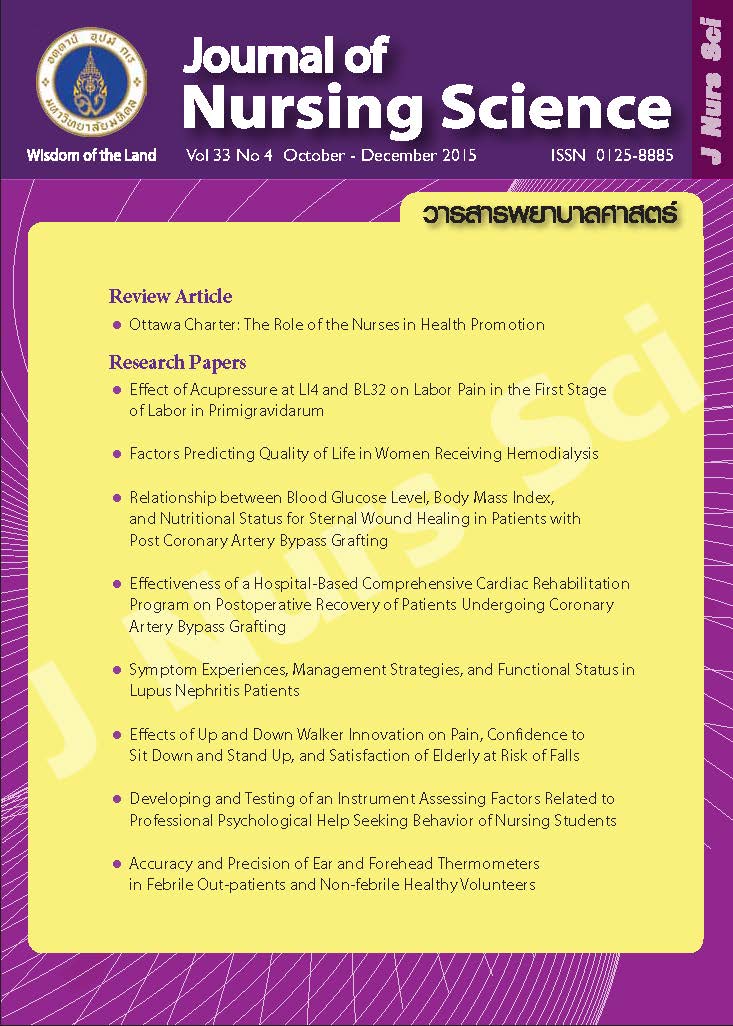Accuracy and Precision of Ear and Forehead Thermometers in Febrile Out-patients and Non-febrile Healthy Volunteers
Main Article Content
Abstract
Purpose: To study the accuracy and precision of ear and forehead thermometers compare to oral thermometer in febrile out-patients and non-febrile healthy volunteers.
Design: A method-comparison study.
Methods: The subjects were 120 febrile out-patients and 120 non-febrile healthy volunteers at Golden Jubilee Medical Center. Each Subject was measured body temperature by oral, forehead, and ear thermometers respectively. Accuracy and precision of the ear and forehead thermometers compared with oral thermometer as the reference were calculated and graphed using the Bland-Altman method. Bias and precision between two devices were set as below or equal to ± .3; ± .5 of the prior statistical analysis according to experts’ recommendation.
Main findings: Average differences for ear and forehead to oral thermometers were - .09 ± .32 and .09 ± .36 degree Celsius respectively in febrile out-patients. Average differences for ear and forehead to oral thermometers were .02 ± .35 and .37 ± .38 degree Celsius respectively in healthy volunteers.
Conclusion and recommendations: The findings revealed that bias and precision values for ear and forehead thermometry to reference oral thermometer met the criteria of experts’ recommendation in febrile out-patients. Thus ear and forehead thermometers could be used with right technique to assess febrile condition in out-patients.
การศึกษาความถูกต้องและแม่นยำของเครื่องวัดอุณหภูมิทางหูและหน้าผาก ในผู้ป่วยนอกมีไข้และอาสาสมัครไม่มีไข้
บทคัดย่อ
วัตถุประสงค์: เพื่อศึกษาความถูกต้องและแม่นยำของปรอทวัดไข้ทางหูและหน้าผาก เปรียบเทียบกับทางปากในผู้ป่วยนอกมีไข้และอาสาสมัครไม่มีไข้
รูปแบบการวิจัย: การวิจัยเปรียบเทียบ
วิธีดำเนินการวิจัย : กลุ่มตัวอย่างเป็นผู้ป่วยนอกมีไข้ 120 คน และอาสาสมัครไม่มีไข้ 120 คน ที่ศูนย์การแพทย์กาญจนาภิเษก กลุ่มตัวอย่างแต่ละราย ได้รับการวัดอุณหภูมิร่างงกายดว้ ยปรอททางหู หน้าผาก และปาก ตามลำดับ คำนวณความถูกต้อง (ความแตกต่างของอุณหภูมิร่างกายจากการวัด 2 วิธี) และแม่นยำ (ส่วนเบี่ยงเบนมาตรฐานของค่าความแตกต่าง) ของอุณหภูมิทางหูและหน้าผากเปรียบเทียบกับทางปาก ซึ่งใช้เป็นมาตรฐานอ้างอิง โดยใช้สถิติ Bland-Altman ก่อนวิเคราะห์ผลทางสถิติผู้วิจัย ได้กำหนดค่าความถูกต้อง และแม่นยำจากการวัด 2 วิธี ไม่เกิน ± .3; ± .5 ตามเกณฑ์ที่ผู้เชี่ยวชาญเสนอแนะไว้
ผลการวิจัย: ผู้ป่วยนอกมีไข้ค่าความแตกต่างของอุณหภูมิที่วัดทางหูและหน้าผากเปรียบเทียบกับทางปากมีค่า - .09 ± .32 และ .09 ± .36 องศาเซลเซียสตามลำดับ สำหรับอาสาสมัครไม่มีไข้ค่าความแตกต่างของอุณหภูมิที่วัดทางหูและหน้าผากเปรียบเทียบกับทางปาก มีค่า .02 ± .35 และ .37 ± .38 องศาเซลเซียสตามลำดับ
สรุปและข้อเสนอแนะ: ผลการศึกษาแสดงให้เห็นว่าความถูกต้องและแม่นยำของอุณหภูมิทางหูและหน้าผากเปรียบเทียบกับทางปาก อยู่ในเกณฑ์ที่ผู้เชี่ยวชาญยอมรับ ในผู้ป่วยมีไข้ ดังนั้น การใช้ปรอทวัดไข้ทางหู และทางหน้าผากอย่างถูกวิธี สามารถใช้วัดอุณหภูมิร่างกายเพื่อประเมินภาวะไข้ในผู้ป่วยนอกได้
คำสำคัญ: ความถูกต้อง ความแม่นยำ ปรอททางหู ปรอททางหน้าผาก ผู้ป่วยนอกมีไข้
Article Details
Copyright Notice: Nursing Science Journal of Thailand has exclusive rights to publish and distribute the manuscript and all contents therein. Without the journal’s permission, the dissemination of the manuscript in another journal or online, and the reproduction of the manuscript for non-educational purpose are prohibited.

Disclaimer: The opinion expressed and figures provided in this journal, NSJT, are the sole responsibility of the authors. The editorial board bears no responsibility in this regard.

